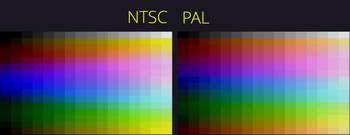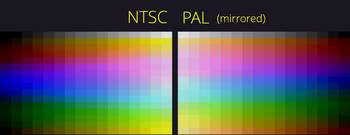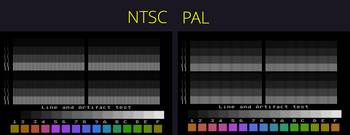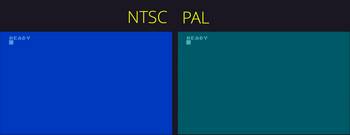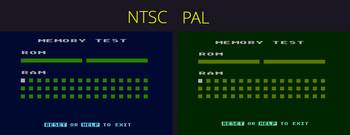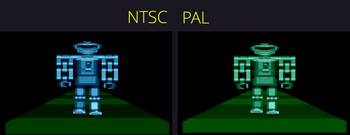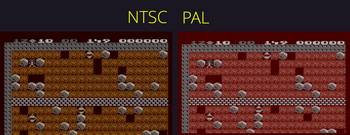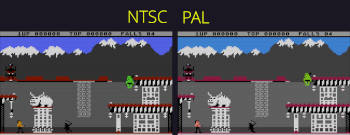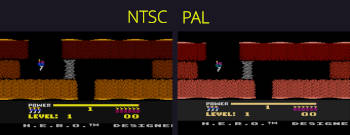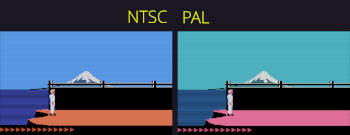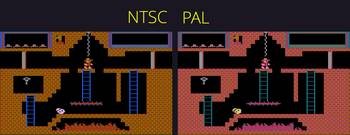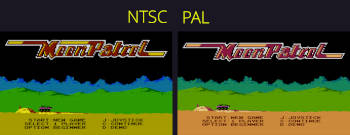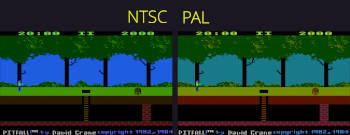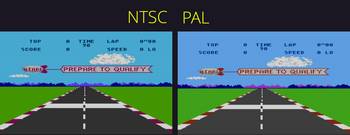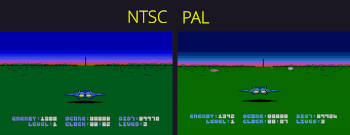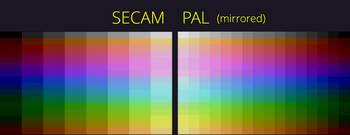Atari's expertise: a very colourful world
While their competitors only offered 8 or 16 colours, very often saturated primary colours, the Atari computers stood out with their 256 colour palette full of nuances and subtleties.
| Computer | Release date | Number of colours in palette | |||||
|---|---|---|---|---|---|---|---|
| Mono chrome | 8 | 16 | 27 | 128 | 256 | ||
| Commodore PET | Jan 1977 | 2 | |||||
| Apple II | Jun 1977 | 16 | |||||
| Tandy/Radio Shack TRS-80 | Aug 1977 | 2 | |||||
| Atari 400/800 (CTIA) | Nov 1979 | 128 | |||||
| Tandy/Radio Shack TRS-80 Color Computer | Sep 1980 | 8 | |||||
| Commodore VIC-20 | 1981 | 16 | |||||
| Texas Instruments TI-99/4A | Jun 1981 | 16 | |||||
| Sinclair XZ Spectrum | Apr 1982 | 16 | |||||
| Atari 400/800 (GTIA) | 1982 | 256 | |||||
| Commodore 64 | Aug 1982 | 16 | |||||
| Amstrad CPC 464 | Apr 1984 | 27 | |||||
I invite you to contemplate the "pause" mode of the game "Chimera", which is very impressive.
For the video: Altirra emulator, Atari 800XL, PAL, 1983 OS rev. 2.
And more impressive, much more impressive, this demo "15 Hues" which presents a real tour de force. Beautiful and bluffing, isn't it?
For the video: Altirra emulator, Atari 800XL, PAL, 1983 OS rev. 2.
NTSC & PAL: equivalent but not strictly identical
Only, one detail probably escaped most users at the time. This 256-colour palette is not exactly the same in NTSC and PAL.
The two palettes are equivalent, but not strictly identical. There are very similar shades, but they are not necessarily numbered the same. For example, the first 16 shades (colour 0) are a gradient from black to white in both palettes, so the match is perfect. But for the next 16 shades (colour 1), the difference is noticeable: in NTSC, it is a gradient from dark ochre to golden yellow, whereas in PAL, it is rather a gradient from red-orange to pure orange. Then it's case by case for each colour.
Take a close look at the two NTSC and PAL palettes shown here. In the second image, the PAL palette has been mirrored vertically so that the colours can be better compared at their maximum intensity. Apart from the first white gradient (colour 0), the two palettes appear to be offset.
Note that in all these NTSC/PAL comparison images, the original images have been cropped and their ratio changed, for the sole purpose of facilitating the comparison. So the ratio difference usually seen between the two formats has been eliminated: these are not exactly the original images, but it is easier to compare.
All screenshots were made with the Altirra emulator, Atari 800XL, OS ver. 2, NTSC or PAL.
This is also visible in Atari BASIC:
A subject not to be ignored by programmers
What may seem like an unimportant curiosity can become very noticeable in some cases if the programmer has completely ignored it. I have two practical examples to show you, which have exactly the same cause: the use of colour number 10 (hex: $0A) and its 16 gradations which is a slightly metallic blue in NTSC and a water green in PAL.
In the Atari self-test (XL & XE), the memory test is done on a blue background in NTSC while the background is green in PAL.
In the "Atari C.E.S. 1985" demo, the robot is metallic blue in NTSC, while it is green in PAL.
Let's be clear: these differences in rendering in NTSC and PAL can be avoided simply if the programmer tests the colour system of the machine running the program: is this computer NTSC or PAL? An examination of memory address 53268 gives the answer: 15 for NTSC and 1 for PAL.
Instead of hard-coding "the background colour of the screen is colour number 10 (hex: $0A)", it is recommended to program: "if the computer is NTSC, the background colour of the screen is colour number 10 (hex: $0A), otherwise it is colour number 9 (hex: $09)".
I invite you to look at some very well known games for comparison.
What about SECAM?
This discussion so far has only been about NTSC and PAL systems, but what does this 256 colour palette look like in SECAM?
Well, for starters, SECAM computers use a FGTIA graphics chip that produces 8 (FGTIA), not 16 (GTIA) shades of each colour. So the palette is 128 colours.
Secondly, the PAL and SECAM colours are arranged in exactly the same place in the palette. The difference is therefore in the number of shades. So we find an "almost" equivalent rendering, but less fine in SECAM, because less rich in the number of colour shades. In most video games of the time, the difference is barely perceptible. Mind you, I'm not saying it's unimportant, au contraire : the number of colours is still divided by two. But since it is extremely rare for a game to use two successive shades of the same colour in the palette, then the difference between PAL and SECAM is difficult to make in this particular case.
Not high fidelity
Back in the 1980s, the fidelity of colour reproduction was not exemplary either. The RF Antenna video signal was of very variable quality, easily disturbed, and the living room TV sets were not professional video monitors impeccably calibrated for a faithful reproduction either. On TV sets that were equipped with it, the "Automatic Fine Tuning Control" was used to adjust the fine tuning and also the hue, saturation, contrast, and brightness to preset ranges. These automatic adjustements overrode the settings of the corresponding separate controls, which then functioned only in narrow ranges. To demonstrate this lack of fidelity in colour reproduction, one only had to go to a department store and compare the images and colours of the same picture on all the TV sets in the shop.
Since the colour palette of Atari computers does not consist of just a few saturated colours but a myriad of different colours and tones, describing them in words was not easy. Atari did try to do this in the various Atari BASIC manuals distributed over the years — changing their minds several times about the names of the colours. Incidentally — and this is a glaring mistake — the colour descriptions were the same in the Atari BASIC manuals distributed in the USA (NTSC) and in other English-speaking PAL countries. Never mind. There is no need to make an exhaustive inventory here of all these listings of colours.
To quote just one, I particularly like the description of the NTSC-palette colours found in the book "Your Atari Computer (1982 Second XL edition) (1982) (McGraw-Hill)", which attempts not to describe each colour with a single word but rather each colour as a gradient from one colour to another.
| Colour # | Description | Colour # | Description |
|---|---|---|---|
| 00 | Black to white | 08 | Royal blue to baby blue |
| 01 | Brown to gold | 09 | Turquoise blue |
| 02 | Orange to yellow | 10 | Ultramarine to powder blue |
| 03 | Terra cotta to pink | 11 | Midnight blue to aquamarine |
| 04 | Mulberry to magenta | 12 | Sea green to turquoise green |
| 05 | Violet to lavender | 13 | Forest green to |
| 06 | Indigo to white | 14 | Kelly green |
| 07 | Sky blue | 15 | Olive Khaki to yellow |
The adjustable colour plot
The colours of the images are correctly adjusted in the factory during the manufacturing process. However, if you find that the text in Atari BASIC, for example, is not on a blue background but on pink or another colour, then it is possible that the colour setting has been changed by a previous owner. Almost all Atari computers{1} have an externally accessible colour plot — accessible without opening the chassis. Turn the computer over and look carefully at all the holes. Most of them are for screws (especially on the edges), but one of the holes actually has a knob that can be turned with a flathead screwdriver. Just turn it slightly to the right or left to adjust the colours. Do not force it. Take it easy, and turn only a little.
{1} On the XEgs (Atari XE Game System), this setting, this colour plot also exists but is not available outside the chassis. You have to open the computer to access it.
Knowledge base article: kb-hardware-0002-atari-8bit-256-colors
REV. 014.
